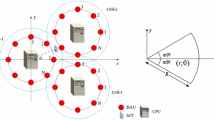Abstract
In this paper, the downlink capacity analysis of distributed antenna systems (DAS) with multiple receive antennas in Nakagami-m fading multicell environment is presented. According to the performance analysis, and using mathematical manipulation, we derive the probability density function (PDF) of the effective signal to interference plus noise ratio of the system. Based on the obtained PDF, an exact closed-form expression of DAS capacity is derived. This expression includes the existing capacity expression as a special case, and avoids the error in the latter. Thus, it can provide good theoretical performance evaluation for downlink DAS. Computer simulation shows that the theoretical analysis is in good agreement with simulation result. Moreover, the increase of receive antenna and/or Nakagami fading parameter m can improve the capacity effectively.



Similar content being viewed by others
References
Chen X, Zhang Z, Chen H-H (2010) On distributed antenna systems with limited feedback precoding: opportunities and challenges. IEEE Wireless Commun 17(2):80–88
Chen H.-M, Chen Ming (2009) Capacity of the distributed antenna systems over shadowed fading channels. In : Proc. IEEE VTC’09, pp. 1–4
Dai L, Zhou S, Yao Y (2005) Capacity analysis in CDMA distributed antenna systems. IEEE Trans Wireless Commun 4:2613–2620
Choi W, Andrews JG (2007) Downlink performance and capacity of distributed antenna systems in a multicell environment. IEEE Trans Wireless Commun 6:69–73
Park J, Song E, Sung W (2009) Capacity analysis for distributed antenna systems using cooperative transmission schemes in fading channels. IEEE Trans Wireless Commun 8:586–592
Li X, Luo M, Zhao M, Huang L, Yao Y (2009) Downlink performance and capacity of distribute antenna system in multi-user scenario. In: IEEE intentional conference on wireless communications, networking and mobile computing, pp.1–4
Alouini MS, Goldsmith AJ (2000) Adaptive modulation over Nakagami fading channels. Wirel Pers Commun 13:119–143
Xiangbin Yu, Dong T, Xu D, Bi G (2010) Performance of space-time block coded CDMA system over Nakagami-m fading channels. Int J Electron 97(9):1035–1049
Gradshteyn IS, Ryzhik IM (2007) Table of integrals, series, and products, 7th edn. Academic, San Diego, CA
Lombardo P, Fedele G, Rao MM (1999) MRC performance for binary signals in Nakagami fading with general branch correlation. IEEE Trans Commun 47(1):44–52
Acknowledgments
The authors would like to thank for the anonymous reviewer and editor for their valuable comments and suggestions, which greatly improve the quality of this paper. The work was supported in part by National Natural Science Foundation of China (61172077), Doctoral Fund of Ministry of Education of China (20093218120021), the Fundamental Research Funds for the Central Universities (NS2012075), National Key Project of Chinese Ministry of Science and Technology (2009ZX03003-006-03), and Shanghai Municipal Natural Science Foundation (10ZR1436000).
Author information
Authors and Affiliations
Corresponding author
Rights and permissions
About this article
Cite this article
Yu, X., Yang, Y., Li, M. et al. Capacity analysis of distributed antenna systems in MIMO Nakagami fading multicell environment. Ann. Telecommun. 67, 589–595 (2012). https://doi.org/10.1007/s12243-012-0301-3
Received:
Accepted:
Published:
Issue Date:
DOI: https://doi.org/10.1007/s12243-012-0301-3




